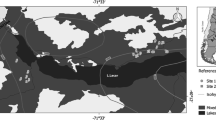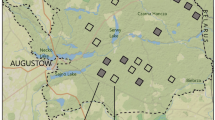Abstract—
This paper presents the results of research into the role of various types of microsites (flat under- and intercrown areas, stumps, fallen logs, mounds, and pits) in the natural regeneration of trees in uneven-aged dark coniferous boreal tall-herb spruce–fir forests of the northern Urals. Areas of microsites of various types have been identified; a general description of natural tree regeneration is provided; the association of undergrowth of various tree species with different microsites was determined; and the undergrowth distribution by ontogenetic states has been assessed. The lowest undergrowth density was registered on flat sites occupying the major part of the community area, while the highest density was detected on elevated microsites (fallen logs, stumps, and mounds) the total area of which is pretty small. The highest density of the undergrowth of all species was observed on stumps. On mounds and fallen logs, it was 4.3 and 3.0 times lower, respectively. It is shown that elevated microsites (stumps, fallen logs, and mounds) are required for successful survival of the undergrowth of various tree species in boreal tall-herb forests.



Similar content being viewed by others
REFERENCES
Aleynikov, A.A. and Efimenko, A.S., Characteristics of the natural regeneration of Siberian pine (Pinus sibirica) in large-fern and tall-herb forests of the Northern Urals, Vestn. MGUL, Lesn. Vestn., 2012, vol. 92, no. 9, pp. 52–57.
Aleynikov, A.A. and Laznikov, A.A Population structure of woody species of spruce–fir forests of different age in the Northern Urals, Vestn. MGUL, Lesn. Vestn., 2012, no. 2, pp. 32–37.
Aleynikov, A.A., Smirnov, N.S., and Smirnova, O.V., Tall-herb boreal forests on North Ural, Russ. J. Ecosyst. Ecol., 2016, vol. 1, no. 3. https://doi.org/10.21685/2500-0578-2016-3-3
Aleynikov, A.A., Tyurin, A.V., and Efimenko, A.S., Features of formation of micromosaic structure of coniferous forests in the Northern Urals, Lesotekh. Zh., 2017, no. 2, pp. 42–54.
Atlas Respubliki Komi po klimatu i gidrologii (Atlas of the Republic of Komi on Climate and Hydrology), Moscow: Drofa, 1997.
Bace, R., Svoboda, M., and Janda, P., Density and height structure of seedlings in subalpine spruce forests of Central Europe: logs vs. stumps as a favorable substrate, Silva Fennica, 2011, vol. 45, no. 5, pp. 1065–1078.
Bace, R., Svoboda, M., Pouska, V., and Janda, P., Natural regeneration in Central-European subalpine spruce forests: which logs are suitable for seedling recruitment?, Forest Ecol. Manage., 2012, vol. 266, pp. 254–262.
Bellingham, P.J. and Richardson, S.J., Tree seedling growth and survival over 6 years across different microsites in a temperate rain forest, Can. J. For. Res., 2006, vol. 36, no. 4, pp. 910–918.
Bobkova, K.S. and Bessonov, I.M., Natural regeneration in the middle-taiga spruce forests in the European Northeast, Lesovedenie, 2009, no. 5, pp. 10–16.
Chumin, V.T., The role of deadwood in the process of renewal of spruce forests, Sb. Tr. Dal’NIILKh, 1965, no. 7, pp. 135–148.
Efimenko, A.S. and Aleynikov, A.A., Confinement of the undergrowth of trees to microsites in large-fern forests of the Northern Urals, in Mater. Vseros. nauch. konf. “Lesnye biogeotsenozy boreal’noi zony: geografiya, struktura, funktsii, dinamika” (Proc. Sci. Conf. “Forest Biogeocenoses of the Boreal Zone: Geography, Structure, Function, and Dynamics”), Krasnoyarsk: Sib. Otd. Ross. Akad. Nauk, 2014, pp. 271–274.
Evstigneev, O.I. and Gornova, M.V., Microsites and maintenance of floristic diversity of tall-herb spruce forests (a case study of the Boloto Ryzhukha natural monument, Bryansk oblast), Russ. J. Ecosyst. Ecol., 2017, vol. 2, no. 2. https://doi.org/10.21685/2500-0578-2017-2-2
Gensiruk, S.A., Natural regeneration of spruce under mountainous conditions of the Carpathians, Les. Zh., 1958, no. 5, pp. 3–12.
Goncharov, A.A., Khramova, E.V., and Tiunov, A.B., Spatial variations in the trophic structure of soil animal communities in boreal forests of Pechora–Ilych Nature Reserve, Eurasian Soil Sci., 2014, vol. 47, no. 5, pp. 441–448.
Gorshenin, N.M., Krinitskii, G.T., and Savich, I.P., Influence of grass cover of clearings on regeneration of European beech and methods for determining the undergrowth viability, Lesovedenie, 1972, no. 4, pp. 41–49.
Gryaz’kin, A.V., Vozobnovitel’nyi potentsial taezhnykh el’nikov (na primere el’nikov Severo-Zapada Rossii) (Regrowth Potential of Boreal Spruce Forests (a Case Study of Spruce Forests of the North-West Russia)), St. Petersburg: SPbGLTA, 2001.
Harmon, M., Retention of needles and seeds on logs in Picea sitchensis–Tsuga heterophylla forests of coastal Oregon and Washington, Can. J. Bot., 1988, vol. 67, pp. 1833–1837.
Harmon, M. and Franklin, J., Tree seedlings on logs in Picae–Tsuga forests of Oregon and Washington, Ecology, 1989, vol. 70, no. 1, pp. 48–59.
Hofgaard, A., Structure and regeneration patterns in a virgin Picea abies forest in northern Sweden, J. Veget. Sci., 1993, vol. 4, pp. 601–608.
Il’chukov, S.V., Horizontal structure of spruce regrowth in mature middle-taiga spruce forests, Les. Zh., 2008, no. 1, pp. 64–68.
Karpachevskii, L.O., Kuraeva, E.N., Minaeva, T.Yu., and Shaposhnikov, E.S., Demutation processes in forests damaged by solid windthrows, in Suktsessionnye protsessy v zapovednikakh Rossii i problemy sokhraneniya biologicheskogo raznoobraziya (Succession Processes in the Russian Reserves and the Problems of Biological Diversity Conservation), Smirnova, O.V. and Shaposhnikov, E.S., Eds., St. Petersburg: RBO, 1999, pp. 380–387.
Korennye elovye lesa Severa: bioraznoobrazie, struktura, funktsii (Indigenous Spruce Forests of the North: Biodiversity, Structure, and Functions), St. Petersburg: Nauka, 2006.
Kuuluvainen, T. and Juntunen, P., Seedling establishment in relation to microhabitat variation in a windthrow gap in a boreal Pinus sylvestris forest, J. Veget. Sci., 1998, vol. 9, no. 4, pp. 551–562.
Lashchinskii, N.N., Makhatkov, I.D., and Lashchinskii, N.N., Jr., Effect of herbage on the regeneration of trees in dark conifer forests of Salair, Lesovedenie, 1991, no. 1, pp. 66–69.
Leont’ev, A.M., Cone-bearing by the Siberian spruce in the upper Pechora region, Tr. Pechoro-Ilych. Zapov., 1963, vol. X, pp. 5–87.
Lugovaya, D.L., Smirnova, O.V., Zaprudina, M.V., Aleynikov, A.A., and Smirnov, V.E., Micromosaic structure and phytomass of ground vegetation in main types of dark conifer forests in the Pechora–Ilych State Nature Reserve, Russ. J. Ecol., 2013, vol. 44, no. 1, pp. 1–8.
McCarthy, J., Gap dynamics of forest trees: a review with particular attention to boreal forests, Environ. Rev., 2001, vol. 9, pp. 1–59.
Narukawa, Y. and Yamamoto, S., Effects of dwarf bamboo (Sasa sp.) and forest floor microsites on conifer seedling recruitment in a subalpine forest, Japan, Forest Ecol. Manage., 2002, vol. 163, no. 1, pp. 61–70.
Narukawa, Y. and Yamamoto, S., Development of conifer seedlings roots on soil and fallen logs in boreal and subalpine coniferous forests of Japan, Forest Ecol. Manage., 2003, vol. 175, nos. 1–3, pp. 131–139.
Obnovlenskii, V.M., On microrelief influence on spruce regeneration, Botanika, 1935, no. 3, pp. 90–95.
Ripa, S.I., The role of windthrow–soil complexes in the regeneration of tree species and in maintaining the biodiversity of natural beech and dark coniferous–beech forests of the Ukrainian Carpathians, Russ. J. Ecosyst. Ecol., 2017, vol. 2, no. 2. https://doi.org/10.21685/2500-0578-2017-2-3
Simon, A., Gratzer, G., and Sieghardt, M., The influence of windthrow microsites on tree regeneration and establishment in an old growth mountain forest, Forest Ecol. Manage., 2011, vol. 262, no. 7, pp. 1289–1297.
Smirnova, O.V., Aleynikov, A.A., Semikolennykh, A.A., Bovkunov, A.D., Zaprudina, M.V., and Smirnov, N.S., Spatial heterogeneity of soil and vegetation in the coniferous forests of the Pechora–Ilych Nature Reserve, Lesovedenie, 2011, no. 6, pp. 67–78.
Smirnova, O.V., Aleynikov, A.A., Semikolennykh, A.A., Bovkunov, A.D., Zaprudina, M.V., and Smirnov, N.S., Typological and structural diversity of the middle-taiga forests of the Urals, in Raznoobrazie i dinamika lesnykh ekosistem Rossii (Diversity and Dynamics of Forest Ecosystems in Russia), Isaev, A.S., Ed., Moscow: KMK, 2013, book 2, pp. 42–66.
Smolonogov, E.P., Complex zoning of the Urals, in Lesa Urala i khozyaistvo v nikh (Forests of the Urals and Farming in Them), Yekaterinburg: UGLTA, 1995, no. 18, pp. 24–41.
Stephens, E.P., Tree uprooting of trees: a forest process, Proc. Soil Sci. Soc. Am., 1956, vol. 20, no. 1, pp. 113–116.
Szewczyk, J. and Szwagrzyk, J., Tree regeneration on rotten wood and on soil in old-growth stand, Vegetatio, 1996, vol. 122, pp. 37–46.
Tsyganov, A.N., Komarov, A.A., Mitchell, E.A.D., Shimano, S., Smirnova, O., Aleynikov, A., and Mazei, Y., Soil testate amoeba diversity is determined primarily by vegetation and habitat type in pristine taiga, Eur. J. Protistol., 2015, vol. 51, pp. 42–54.
Zielonka, T., When does dead wood turn into a substrate for spruce replacement?, J. Veget. Sci., 2006, vol. 17, pp. 739–746.
ACKNOWLEDGMENTS
This work was performed as part of a State Assignment of the Center for Forest Ecology and Productivity, Russian Academy of Sciences (no. АААА-А18-118052400130-7), with the financial support of the Russian Foundation for Basic Research, projects nos. 19-04-00609 and 16-04-00395.
Author information
Authors and Affiliations
Corresponding author
Ethics declarations
The authors declare that they have no conflict of interest. This article does not contain any studies involving animals or human participants performed by any of the authors.
Additional information
Translated by L. Emeliyanov
Rights and permissions
About this article
Cite this article
Efimenko, A.S., Aleinikov, A.A. The Role of Microsites in the Natural Regeneration of Trees in Boreal Tall-Herb Dark Coniferous Forests of the Northern Urals. Biol Bull Russ Acad Sci 46, 200–209 (2019). https://doi.org/10.1134/S1062359019020055
Received:
Revised:
Accepted:
Published:
Issue Date:
DOI: https://doi.org/10.1134/S1062359019020055




